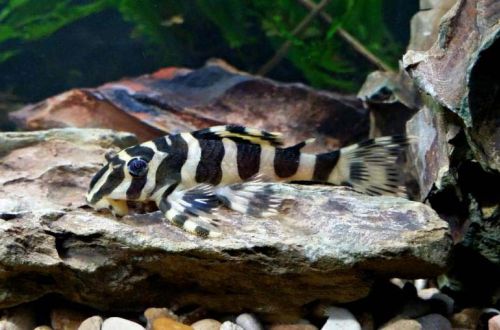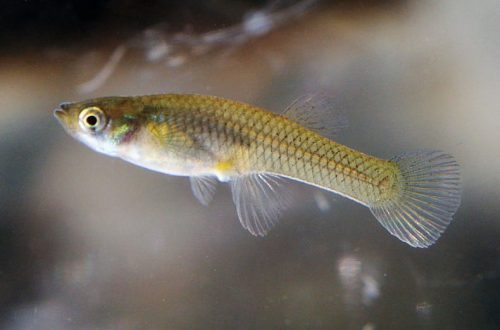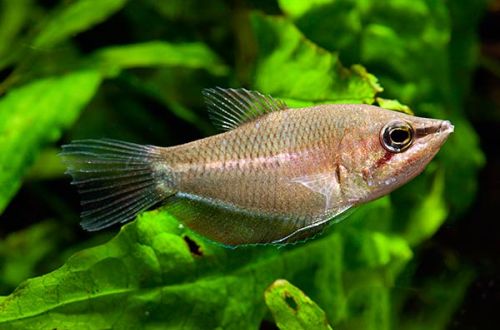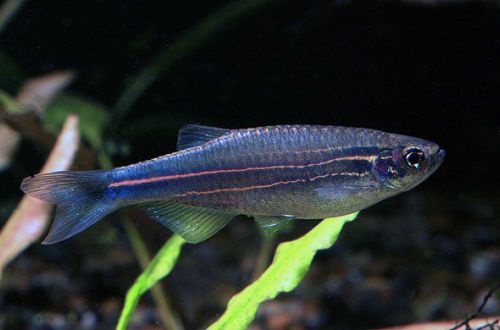
Keris
The Kerry or Purple Emperor Tetra, scientific name Inpaichthys kerri, belongs to the Characidae family. A miniature fish with an original coloration, this primarily applies to males. Easy to keep, unpretentious, easy to breed. It gets along well with other non-aggressive species of a similar or slightly larger size.
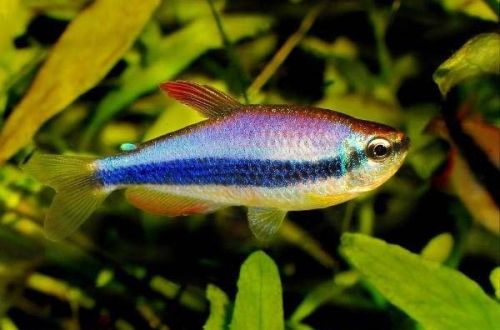
Turinys
Arealas
It comes from the upper basin of the Madeira River – the largest tributary of the Amazon. It lives in numerous river channels and streams flowing through the rainforest. The water is opaque, very acidic (pH below 6.0), colored light brown due to the high concentration of tannins and other tannins released during the decomposition of organic matter (leaves, branches, tree fragments, etc.).
Trumpa informacija:
- Akvariumo tūris – nuo 70 litrų.
- Temperatūra – 24-27°C
- Vertė pH — 5.5–7.0
- Vandens kietumas – minkštas (1-12 dGH)
- Pagrindo tipas – smėlio
- Apšvietimas – prislopintas
- sūrus vanduo – ne
- Vandens judėjimas – mažas/vidutinis
- Žuvies dydis iki 3.5 cm.
- Maistas – bet koks maistas
- Temperamentas – taikus, ramus
- Laikant ne mažiau kaip 8-10 individų pulką
Aprašymas
Adults reach a length of about 3.5 cm. A wide horizontal dark stripe runs along the body, the color is blue with a purple tint. Males are more brightly colored than females, which often have a modest brown with a yellowish tinge. Due to the similarity in color, they are often confused with the Royal or Imperial Tetra, and the almost identical name adds confusion.
maistas
Accepts all types of popular dry, frozen and live foods. A varied diet, such as flakes, granules combined with bloodworms, daphnia, etc., promotes the appearance of brighter colors in the coloration of the fish.
Akvariumo priežiūra ir priežiūra, sutvarkymas
A flock of 8-10 fish will require a tank with a volume of at least 70 liters. In the design I use a sandy substrate with numerous shelters in the form of snags or other decorative elements, dense thickets of plants that can grow in dim light. To simulate natural water conditions, dried fallen leaves, oak bark or deciduous tree cones are dipped to the bottom. Over time, the water will turn into a characteristic light brown color. Before placing the leaves in the aquarium, they are pre-washed with running water and soaked in containers until they begin to sink. A filter with a peat-based filter material can enhance the effect.
Another design or its complete absence is quite acceptable – an empty aquarium, however, in such conditions, the Purple Imperial Tetra will quickly turn into a gray nondescript fish, having lost all the brightness of its color.
Maintenance comes down to regular cleaning of the soil from organic waste (excrement, food residue, etc.), replacing leaves, bark, cones, if any, as well as weekly replacement of part of the water (15–20% of the volume) with fresh water.
Elgesys ir suderinamumas
Peaceful schooling calm fish. They do not respond well to noisy, overly active neighbors such as Barbs or the African Red-Eyed Tetra. Kerry is perfectly compatible with other South American species, such as small tetras and catfish, Pecilobricon, hatchetfish, as well as rasboras.
This species has an undeserved reputation as “fin clippers”. The Purple Tetra does have a tendency to damage the fins of its tankmates, but this only happens when kept in a small group of up to 5-6 individuals. If you support a large flock, then the behavior changes, the fish begin to interact exclusively with each other.
Veisimas / veisimas
Mailiaus atsiradimas galimas net ir bendrame akvariume, tačiau laiku nepersodinus į atskirą talpyklą, jų skaičius bus labai mažas ir mažės kiekvieną dieną. Norint padidinti išgyvenimo tikimybę ir kažkaip susisteminti veisimosi procesą (nerštas nebuvo spontaniškas), rekomenduojama naudoti neršto akvariumą, kuriame poravimosi sezono metu dedamos suaugusios žuvys.
Paprastai tai yra mažas indas, kurio tūris yra apie 20 litrų. Dizainas yra savavališkas, pagrindinis dėmesys skiriamas substratui. Kad kiaušiniai nebūtų suvalgyti, dugnas uždengiamas smulkiaakleliu tinkleliu arba smulkialapiais augalais ar samanomis (pavyzdžiui, Javos samanos). Alternatyvus būdas – uždėti ne mažesnio kaip 1 cm skersmens stiklo karoliukų sluoksnį. Apšvietimas prislopintas, užtenka šildytuvo ir paprasto airlift filtro iš įrangos.
Poravimosi sezono pradžios stimulas – laipsniškas vandens parametrų keitimas bendrame akvariume iki šių reikšmių: pH 5.5–6.5, dH 1–5 esant maždaug 26–27°C temperatūrai. Dietos pagrindas turėtų būti šaldytas arba gyvas maistas.
Atidžiai stebėkite žuvis, netrukus kai kurios jų taps pastebimai suapvalėjusios – tai nuo ikrų išbrinkusios patelės. Paruoškite ir užpildykite neršto rezervuarą vandeniu iš bendruomenės rezervuaro. Padėkite ten pateles, kitą dieną porą didelių patinų, kurie atrodo įspūdingiausiai.
Belieka palaukti, kol nerštas, jo pabaigą gali nustatyti patelės, jos labai „svoris“, o tarp augmenijos (po smulkiu tinkleliu) bus pastebimi kiaušinėliai.
Žuvis grąžinama. Mailius pasirodys per 24–48 valandas, dar po 3–4 dienų pradės laisvai plaukti ieškodamas maisto. Maitinkite specialiu mikromaitinimu.
Žuvų ligos
Subalansuota akvariumo biosistema su tinkamomis sąlygomis yra geriausia garantija nuo bet kokių ligų atsiradimo, todėl pasikeitus žuvims elgesiui, spalvai, neįprastoms dėmėms ir kitiems simptomams, pirmiausia reikia patikrinti vandens parametrus, o tik tada pradėti gydymą.



